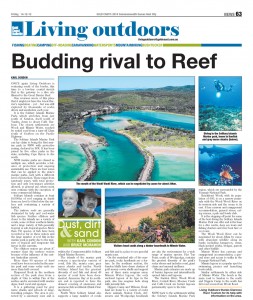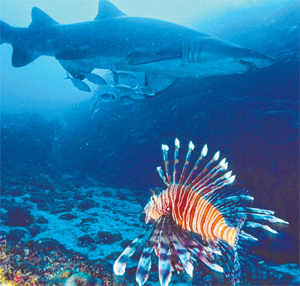By Karl Condon
Article below reproduced from the Gold Coast Bulletin‘s Living Outdoors section, 14 December 2012
 Once again Living Outdoors is venturing south of the border, this time to a low-key coastal stretch that is the gateway to a dive site likened to the Great Barrier Reef.
Once again Living Outdoors is venturing south of the border, this time to a low-key coastal stretch that is the gateway to a dive site likened to the Great Barrier Reef.
One reviewer wrote of this place that it might not have the Great Barrier’s reputation – yet – but was still explored by thousands of scuba divers and snorkelers each year.
It is the Solitary Islands Marine Park, which stretches from just south of Sandon, itself south of Yamba, down to about Coffs Harbour.
The closest settlements are Wooli and Minnie Water, reached by sealed road from a turn-off 12km south of Grafton on the Pacific Highway.
The Solitary Islands Marine Park can lay claim to being the first marine park in NSW with protective zoning, declared in 1991. It has been joined by five other parks in the state, including Cape Byron to the north.
NSW marine parks are classed as multiple use, which provides a balance of protection and ongoing sustainable use. There are four zones that can be applied to the state’s marine parks, each with a different level of protection. These range from sanctuary zones, with total protection and only low-impact activities allowed, to general use, where most uses continue with the exception of some commercial fishing.
Solitary Islands contains at least 10,000ha of reef ranging in depth from sea level to 60m below the surface and containing a variety of habitat.
The inshore reefs are generally dominated by kelp and cool-water fish species. Further offshore and closer to the islands are a variety of corals, some at their southern limits, and a large variety of fish generally tropical or sub-tropical species.
 More than 550 species of fish have been recorded so far in these waters and the large number of reef fish in the marine park is partly due to the mixture of tropical and temperate fish larvae in the currents.
More than 550 species of fish have been recorded so far in these waters and the large number of reef fish in the marine park is partly due to the mixture of tropical and temperate fish larvae in the currents.
The offshore waters are about 1C warmer than the inshore waters because of the influence of the eastern Australian current.
More than 90 species of hard coral have been recorded in the marine park and some rocky reefs are more than half covered.
Pimpernel Rock in the northern section of the park rises from a depth of 50m to within 15m of the surface and is encrusted with marine algae, hard coral and sponges.
It is a gathering point for grey nurse sharks and schools of large, travelling pelagics. The area is protected by a sanctuary zone and is within the Commonwealth’s Solitary Island Marine Reserve.
The islands of the marine park contain a spectacular variety of coral, fish life, manta rays, grey nurse sharks and turtles. North Solitary Island has the greatest diversity of reef fish and about 49 species of coral have been documented Anemone Bay at its northern end is reported to have the densest covering of anemones and anemone fish worldwide (think Finding Nemo).
North West Solitary Island also supports a large number of corals and fish and is a place to see graceful manta rays.
On the mainland side of the marine park, rocky headlands are a feature In the northern section, the Sandon bluffs have dense clusters of gold money cowry shells and support one of three main seagrass areas. Minnie Water lagoon, the only enclosed lagoon of its type in the park, also has seagrass beds along with juvenile fish.
Diggers Camp and Wilsons Headland are home to a variety of rocky shore animals. Station Creek, Arrawarra and Woolgoolga headlands are also the environment for a wide range of marine species. Flat Top Point, south of Woolgoolga, contains the greatest diversity of the park’s rocky shores and includes coral, giant clams and unusual molluscs.
Marine park estuaries are made up of barrier lagoons and intermittently opened lakes and lagoons.
The Sandon River, Wooli Wooli River, Corindi River, Moonee Creek and Coffs Creek are barrier lagoons permanently open to the tide.
Now back to the settlements within the Solitary Islands Marine Park region, which are surrounded by the Yuraygir National Park.
Beachfront Wooli, with its population of 600, is on a narrow peninsula with the Wooli Wooli River on its western side and the ocean to its east. It has caravan and campground accommodation, general stores, eating venues, a pub and bowls club.
It is the stepping-off point for some of the best diving the Solitary Islands Marine Park can offer and is the base for a dive centre, deep sea tours and fishing charters and river boat hire or eco tours.
The Wooli Wooli River can be negotiated for about 20km by canoe with abundant wildlife along its banks including kangaroos, emus, black-necked storks, brolgas, parrots and other birdlife.
Minnie Water has caravan and campground accommodation, a general store and access to walks in the Yuraygir National Park.
Minnie lagoon is a popular spot for swimming, picnics and launching boats safely.
Similar settlements lie either side of Minnie Water. The beach is the main road to Sandon to the north and Diggers Camp to the south has dirt road access from Wooli Road.